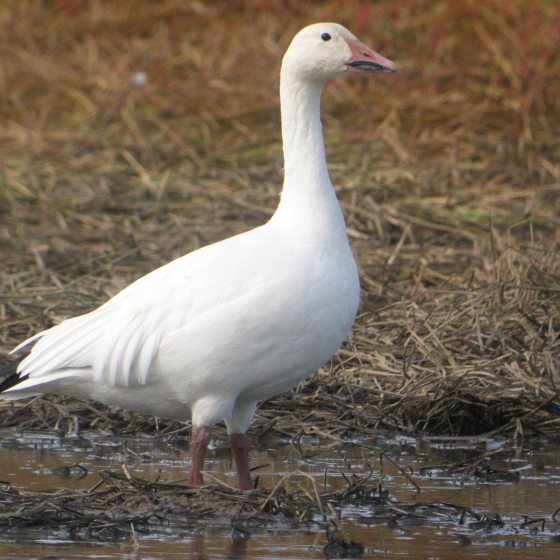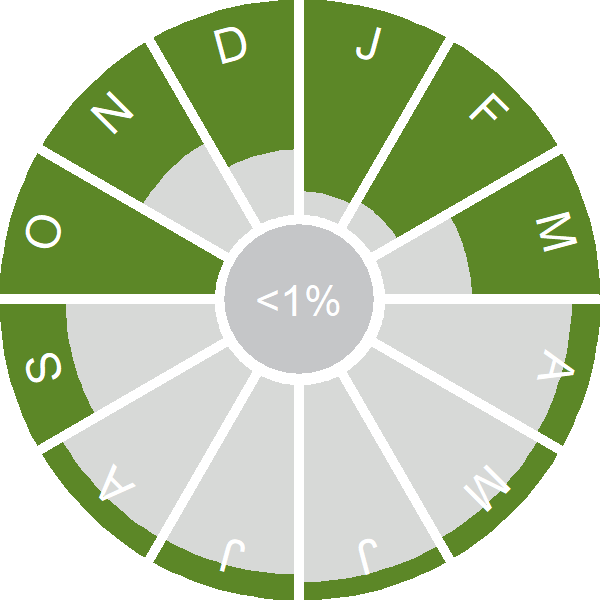Snow Goose

Introduction
Previously only a rare visitor from North America (where numbers have increased markedly), there is now a small, self-sustaining population of this white goose in Argyll.
The Snow Goose occurs in two colour morphs: a 'white' (light) morph and a 'blue' (dark) morph, controlled by a single gene.
Most of the Snow Geese present in Britain are individuals that have escaped from captivity, but a handful of genuine vagrants arrive with visiting Pink-Footed Geese. The breeding range extends from eastern Siberia, across arctic North America to Greenland.

Key Stats
Status and Trends
Conservation Status
Population Change
The Snow Goose is antive of N America, and handful of wild individuals are recorded annually, but most birds are of captive origin, with breeding occurring in some areas. A long-established, but small, population has been present on Coll, Argyll since the 1980s (originating from a feral population that established on Mull) and a further two resident flocks are present in Oxfordshire and Yorkshire; birds from all three flocks have occasionally produced young [Eaton & the Rare Breeding Birds Panel 2023].
Distribution
Although small numbers of genuine vagrant Snow Geese are recorded annually, the majority of individuals recorded during 2007–11 were escapes from captivity. The records of wild Snow Geese are most likely to occur at traditional staging or wintering areas of Pink-footed Geese. The breeding records are all of birds of captive origin and tend to be at sites with ornamental lakes; the only apparently self-sustaining populations were those in Argyll, on northwestern Mull and Coll in the Inner Hebrides.
Occupied 10-km squares in UK
or view it on Bird Atlas Mapstore.
or view it on Bird Atlas Mapstore.
Distribution Change
Change in occupied 10-km squares in the UK
or view it on Bird Atlas Mapstore.
or view it on Bird Atlas Mapstore.
Seasonality
The year-round presence of Snow Geese is a complicated mixture of naturalised residents and a small number of presumed vagrants from North America, the latter most often seen in winter with wild winter goose flocks.
Weekly pattern of occurrence
The graph shows when the species is present in the UK, with taller bars indicating a higher likelihood of encountering the species in appropriate regions and habitats.

Movement
Britain & Ireland movement
Foreign locations of birds ringed or recovered in Britain & Ireland
Dots show the foreign destinations of birds ringed in Britain & Ireland, and the origins of birds ringed overseas that were subsequently recaptured, resighted or found dead in Britain & Ireland. Dot colours indicate the time of year that the species was present at the location.
- Winter (Nov-Feb)
- Spring (Mar-Apr)
- Summer (May-Jul)
- Autumn (Aug-Oct)

Biology
Survival and Longevity
Survival is shown as the proportion of birds surviving from one year to the next and is derived from bird ringing data. It can also be used to estimate how long birds typically live.
View number ringed each year in the Online Ringing Report.
lifespan
Classification, names and codes
Classification and Codes
- Order: Anseriformes
- Family: Anatidae
- Scientific name: Anser caerulescens
- Authority: Linnaeus, 1758
- BTO 2-letter code: SJ
- BTO 5-letter code: SNOGO
- Euring code number: 1630
Alternate species names
- Catalan: oca de les neus
- Czech: husa snežní
- Danish: Snegås
- Dutch: Sneeuwgans
- Estonian: lumehani
- Finnish: lumihanhi
- French: Oie des neiges
- Gaelic: Gèadh-bàn
- German: Schneegans
- Hungarian: sarki lúd
- Icelandic: Snjógæs
- Irish: Gé Shneachta
- Italian: Oca delle nevi
- Latvian: sniega zoss
- Lithuanian: sniegine žasis
- Norwegian: Snøgås
- Polish: sniezyca duza
- Portuguese: ganso-das-neves
- Slovak: hus snežná
- Slovenian: snežna gos
- Spanish: Ánsar nival
- Swedish: snögås
- Welsh: Gwydd yr Eira

